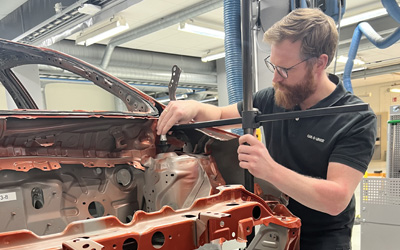Varför välja Academy?
Vi månar om våra kunder, partner och deras personal och fokuserar på att identifiera deras utvecklingsbehov. Anpassade lösningar levereras i form av utbildning och vägledning med stöd av etablerade processer, strukturer och standarder som förbättrar verkstädernas kvalitet, säkerhet och lönsamhet.
- Specialiserade utbildningar: skräddarsydda för våra skadereparationssystem.
- De främsta utbildarna: lär av branschproffs.
- Praktiska övningar: ger dig insikter om hur lösningarna fungerar i praktiken.
- Kontinuerligt lärande: skapa konkurrensfördelar genom att lära dig nya reparationstekniker.

Vad vi erbjuder
Våra kurser utgörs av en välbalanserad blandning av teori och praktiska övningar, som sedan följs upp genom kunskapskontroller. Utbildningsprogrammet kan även helt anpassas efter verkstadens unika behov.
- Grundläggande utbildning: ger dig förmåga att behärska Car-O-Liner®-systemens centrala funktioner.
- Avancerad teknik: förbättra din yrkesskicklighet med kurser på avancerad nivå.
- Kontinuerlig support: vårt intresse för din framgång upphör aldrig.

Var du hittar oss
Professionella utbildningslokaler, små grupper och erfarna utbildare garanterar nöjda deltagare som efter utbildningen utför sitt arbete med ännu större effektivitet och professionalism.
Academy erbjuder kurser på flera platser runt om i världen. Hitta din närmaste utbildningsplats och se vilka kurser som erbjuds.
